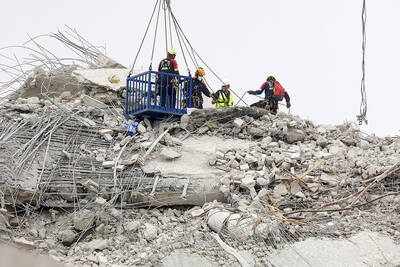According to Nick Cave, the two main influences for The Death of Bunny Munro, his second novel, are the Gospel According to St Mark and the Scum Manifesto by militant feminist Valerie Solanas, a woman perhaps more famous for shooting Andy Warhol. “The male,” wrote Solanas, founder of the Society for Cutting up Men, “is completely egocentric, trapped inside himself, incapable of empathizing or identifying with others, or love, friendship, affection of tenderness ... he is a half-dead, unresponsive lump, incapable of giving or receiving pleasure or happiness.”
Cave’s fictional antihero, Bunny Munro, is Solanas’ misogynistic Everyman made frighteningly, absurdly, hilariously real. Like one of Martin Amis’ early characters — Keith Talent, say, from London Fields — Bunny is an antihero of epic proportions, a booze-addled, nicotine-stained, cocaine-fuelled monster constantly in search of priapic adventure. Or what he, in a moment of not untypical lyrical invention, calls “the fucking Valhalla of all vaginas.”
That this sacredly profane organ belongs, in Bunny’s incessantly fevered imagination, to the pop singer Avril Lavigne only fuels his chronic sexual addiction. It is her thrusting crotch that he continually conjures up, alongside that of the only slightly less suggestive Kylie Minogue, as he cruises the seaside towns of England’s south coast peddling beauty products — “hands shit, face shit, body shit, hair shit” — from the boot of his yellow Fiat Punto.
His attempts to bed virtually every woman who answers the door to him make for a series of often hilarious, sometimes excruciating and, in one instance, shocking interludes in a novel that cloaks its essentially tragic thrust beneath a darkly comic surface.
Cave, now a renowned screenwriter as well as songwriter — he wrote the script for John Hillcoat’s critically acclaimed 2005 outback epic, The Proposition — has some pedigree as a writer of fiction. His first novel, And the Ass Saw the Angel, published in 1989, adhered to the deep southern Gothic strain that also attended his songwriting then.
Having long since written Flannery O’Connor and William Faulkner out of his system, Cave’s prose, like his songs, has become more taut and tender in the intervening years, less in thrall to its influences and to his own dark and brooding onstage persona. Recently, he has been reading Bellow and Updike as well as, intriguingly, Bret Easton Ellis, another writer who, like Cave, has often been castigated for his supposed misogyny. It shows.
As the novel shifts in tone from darkly comic to nightmarish, you sometimes wonder, as is often the case with Easton Ellis, about the psychological well-being of its author. Cave, though, as many of his more willfully melodramatic songs suggest, has always tended towards the extreme in order to ram home a point. (He once began a song with the line: “I stuck a six-inch gold blade in the head of a girl,” and has recently recorded another called No Pussy Blues.)
In this case, his target is the uber-lad culture of contemporary Britain, of which Bunny Munro is an extreme, but always credible, example. Cave satirizes that reductive strain of warped maleness with some glee and an undercurrent of comic disgust, but The Death of Bunny Munro is essentially a tragic tale; a novel that is by turns sick and funny, and sometimes both simultaneously, but that moves inexorably, determinedly, towards its terrible end.
The novel’s three-part structure — the subtitles are Cocksman, Salesman and Deadman — also adheres to the tragic mode even as it sends it up. The hapless protagonist is, as the title warns us, living on borrowed time and seems, somewhere deep down in his overloaded psyche, to be acutely aware of his imminent demise. The narrative begins with the line: “‘I am damned,’ thinks Bunny Munro in a sudden moment of self-awareness reserved for those who are soon to die.” Bunny, in short, is a dead man walking.
The book’s still center, though, and its one redeemable character, is Bunny Munro Junior, a child who hero-worships his errant father while grieving for his mother, who is driven to suicide in the book’s opening chapter by her husband’s incapacity for tenderness, empathy or love. Cave deploys pitch-black humor and a scabrous tone throughout, as signifiers of Bunny Senior’s monumental self-delusion. Like the Gospel of St Mark, this is a narrative that, for all its frantic hurly-burly, is only ever heading towards a foregone, and sacrificially violent, conclusion. Bunny Munro must die, one senses, so that his only-begotten son may live beyond his blighting shadow.
It is not often one reads a novel that includes the names of a pair of famous female pop stars in its acknowledgments. “I would like to thank Kylie Minogue and Avril Lavigne,” writes Cave, “with love, respect and apologies.” Minogue, a friend of Cave’s with whom he has duetted in the past, will undoubtedly forgive him, but one cannot help but wonder what Lavigne will make of such a twisted tale, and one that utilizes her — or, to be more precise, her vagina — as a symbol of impossible, unquenchable and terminally dysfunctional male sexual desire. Whatever, the late Valerie Solanas would almost certainly have approved.

That US assistance was a model for Taiwan’s spectacular development success was early recognized by policymakers and analysts. In a report to the US Congress for the fiscal year 1962, former President John F. Kennedy noted Taiwan’s “rapid economic growth,” was “producing a substantial net gain in living.” Kennedy had a stake in Taiwan’s achievements and the US’ official development assistance (ODA) in general: In September 1961, his entreaty to make the 1960s a “decade of development,” and an accompanying proposal for dedicated legislation to this end, had been formalized by congressional passage of the Foreign Assistance Act. Two

March 31 to April 6 On May 13, 1950, National Taiwan University Hospital otolaryngologist Su You-peng (蘇友鵬) was summoned to the director’s office. He thought someone had complained about him practicing the violin at night, but when he entered the room, he knew something was terribly wrong. He saw several burly men who appeared to be government secret agents, and three other resident doctors: internist Hsu Chiang (許強), dermatologist Hu Pao-chen (胡寶珍) and ophthalmologist Hu Hsin-lin (胡鑫麟). They were handcuffed, herded onto two jeeps and taken to the Secrecy Bureau (保密局) for questioning. Su was still in his doctor’s robes at

Last week the Democratic Progressive Party (DPP) said that the budget cuts voted for by the China-aligned parties in the legislature, are intended to force the DPP to hike electricity rates. The public would then blame it for the rate hike. It’s fairly clear that the first part of that is correct. Slashing the budget of state-run Taiwan Power Co (Taipower, 台電) is a move intended to cause discontent with the DPP when electricity rates go up. Taipower’s debt, NT$422.9 billion (US$12.78 billion), is one of the numerous permanent crises created by the nation’s construction-industrial state and the developmentalist mentality it

Experts say that the devastating earthquake in Myanmar on Friday was likely the strongest to hit the country in decades, with disaster modeling suggesting thousands could be dead. Automatic assessments from the US Geological Survey (USGS) said the shallow 7.7-magnitude quake northwest of the central Myanmar city of Sagaing triggered a red alert for shaking-related fatalities and economic losses. “High casualties and extensive damage are probable and the disaster is likely widespread,” it said, locating the epicentre near the central Myanmar city of Mandalay, home to more than a million people. Myanmar’s ruling junta said on Saturday morning that the number killed had